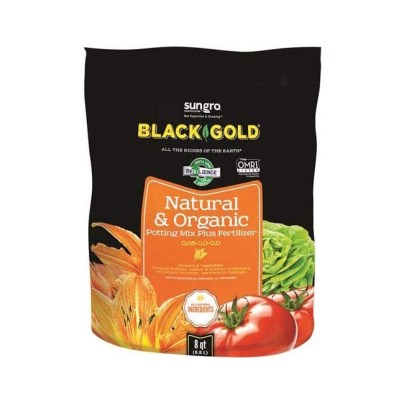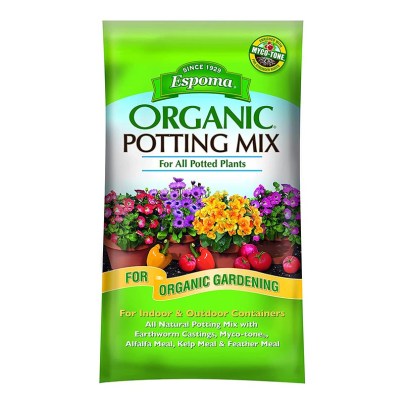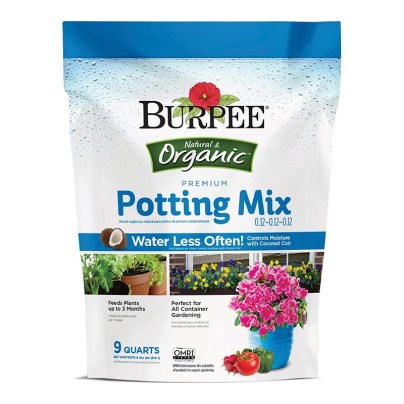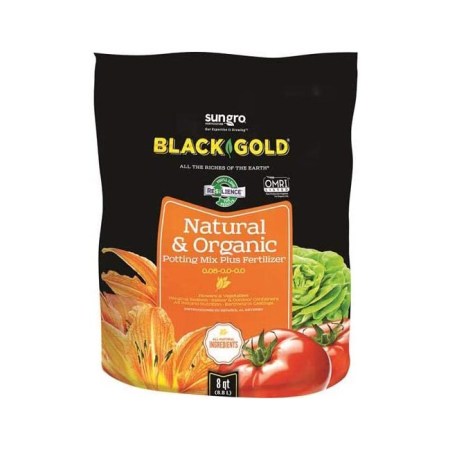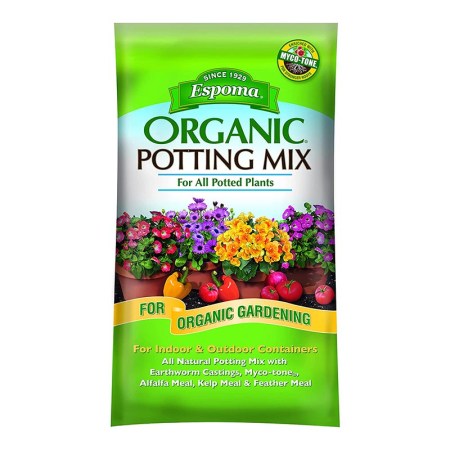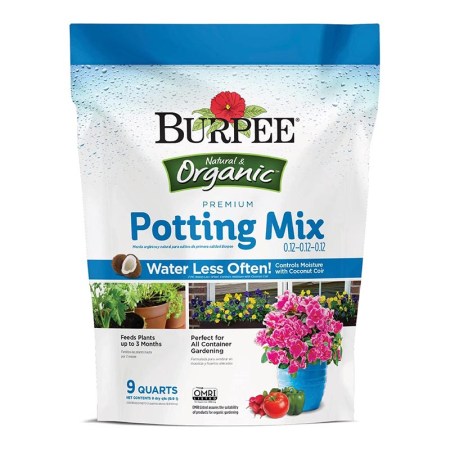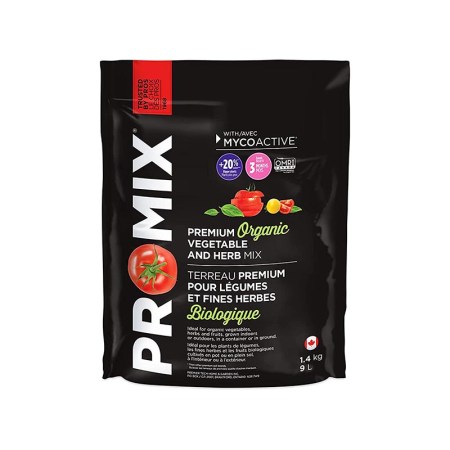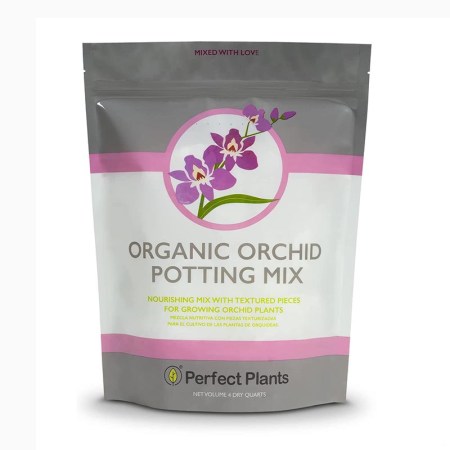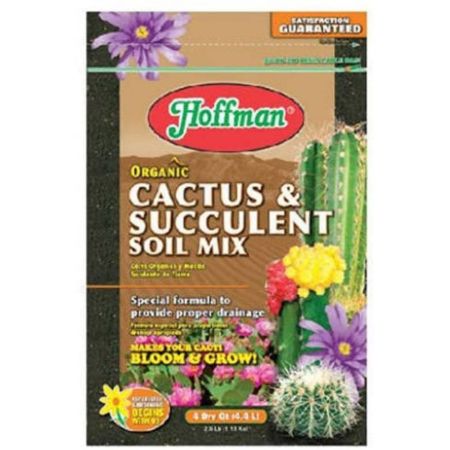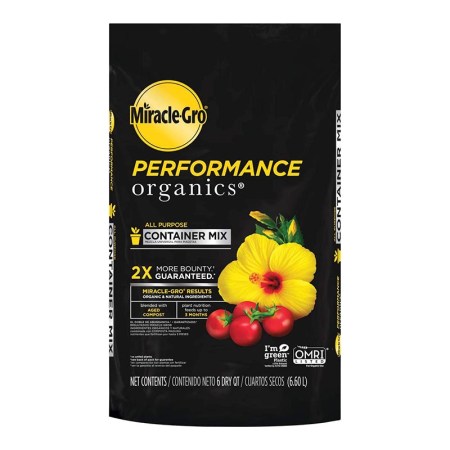We may earn revenue from the products available on this page and participate in affiliate programs. Learn More ›
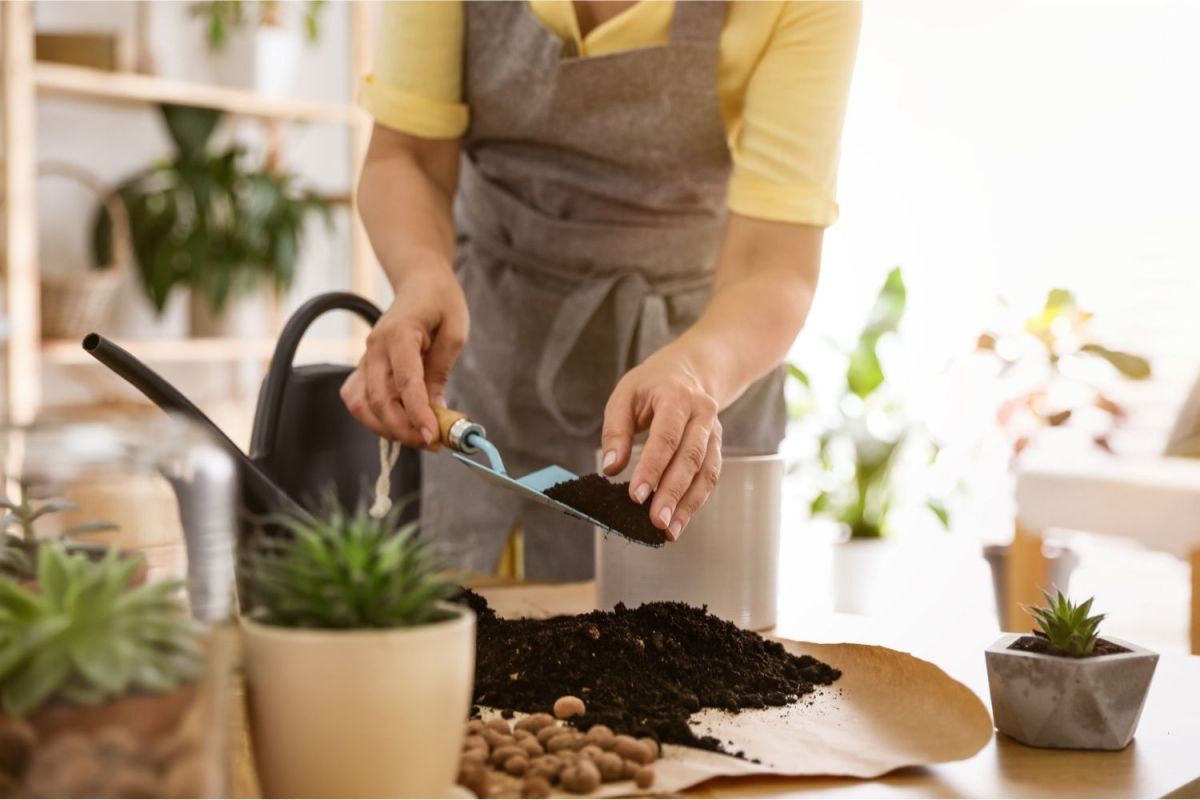
Unlike soil amendments that mix into natural garden soil for gardening, potting soil is an all-in-one mixture for container plantings that contains everything potted plants need to thrive. It’s an essential ingredient for indoor and outdoor container gardening with two major roles: to store and release water and nutrients that plants use; and to provide a stable base for plants to structurally anchor themselves.
Potting soil (also called “potting mix”) contains ingredients in various proportions for different growing conditions and plant types. Additives like fertilizer make big differences in overall performance as well.
Ahead, find shopping criteria and view the best organic potting soil for container gardening needs.
- BEST OVERALL: Black Gold 1302040 8-Quart All Organic Potting Soil
- RUNNER-UP: Espoma AP16 16-Quart Organic Potting Mix
- BEST BANG FOR THE BUCK: Burpee 9-Quart Premium Organic Potting Natural Soil
- BEST FOR VEGETABLES: Pro-Mix Organic Vegetable and Herb Potting Mix
- BEST FOR ORCHIDS: Perfect Plants 4-Quart All Natural Orchid Potting Mix
- CACTI & SUCCULENTS PICK: Hoffman 10404 Organic Cactus and Succulent Soil Mix
- BEST FOR RAISED BEDS: Miracle-Gro Performance Organics Container Mix
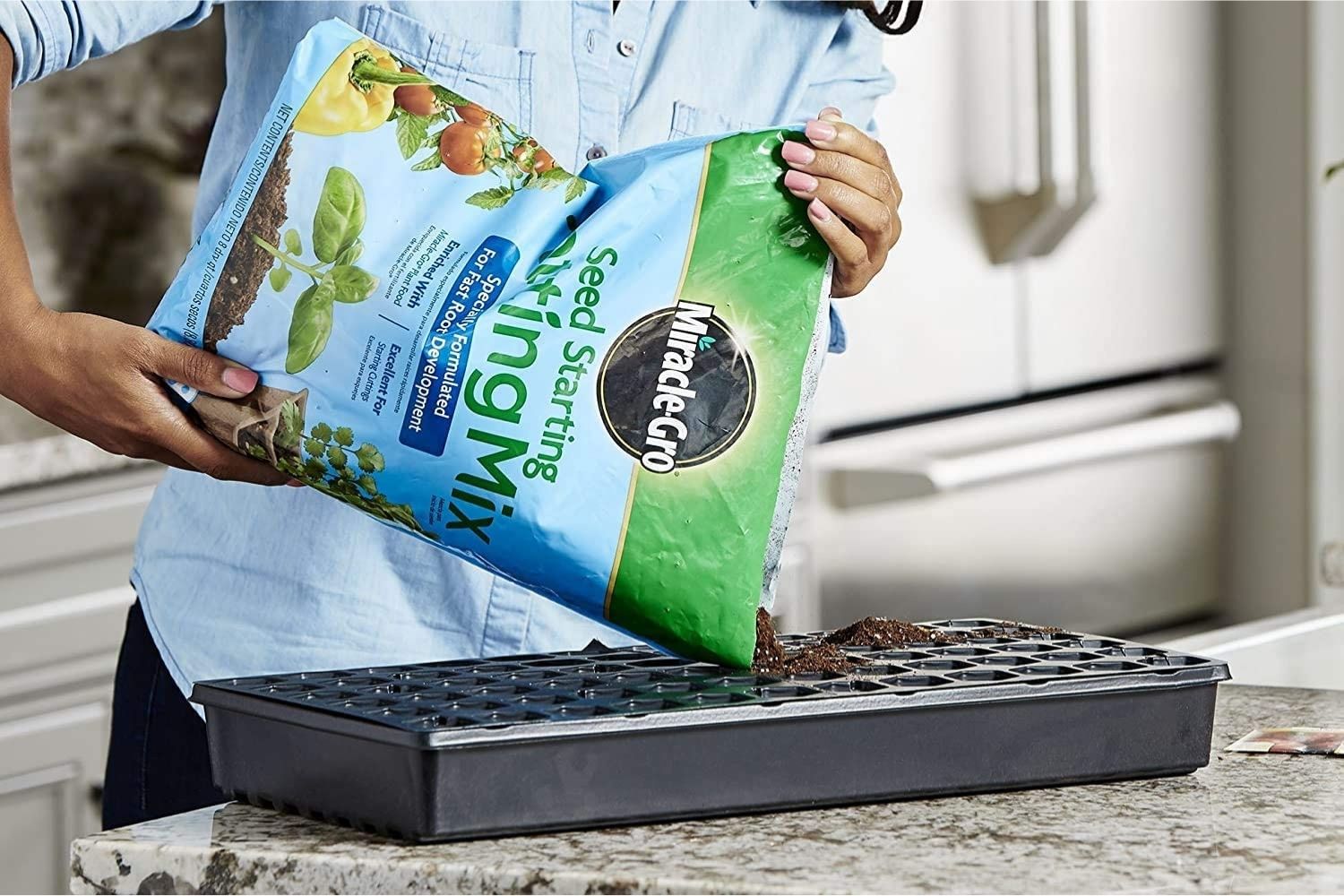
How We Chose the Best Potting Soil Mixes
After we researched the correct nutrients for successful potted plant growth, the types of soils offered, and the considerations that every successful plant owner should have, we came up with the above list to satisfy the needs of any and all plants in their growth from seed to bloom.
We chose mixes that included such essential ingredients as Canadian sphagnum peat moss, perlite, and wetting agents, and our picks favor a slow-release nature of plant food. Shoppers will likely recognize the name brands of these products because we valued the trustworthiness of these well-known manufacturers and their loyal customer base.
Many of these mixes are also made to be used in both indoor and outdoor environments for maximum versatility, while the lightweight nature of some of the soils helps for portability when pouring or repotting. Overall, each of these options was selected due to user-friendliness and all-around reliability in growing potted plants.
Our Top Picks
Potting soil is used for general container gardening and for very specific plant types. In this lineup, shoppers will find some of the top choices for common uses and plant types.
Best Overall
Black Gold 1302040 8-Quart All Organic Potting Soil
See ItBlack Gold potting soil is a nutrient-rich mix for growing most types of plants in containers. Its slow-release fertilizer blend supports lush foliage, deep rooting, and overall plant health. Black Gold potting mix contains Canadian sphagnum peat moss plus worm castings, forest humus, and pumice. The Organic Materials Review Institute (OMRI) certification ensures this product is certified organic.
This potting soil is suitable for both indoor and outdoor use. Its moderate drainage and water-retention capabilities and its medium particle size make it work well for houseplants, hanging baskets, patio containers, and container vegetable and herb gardens. It’s a nearly all-purpose choice for growers with different kinds of potted plants.
Product Specs
- Key ingredients: Peat moss, loam, perlite, pumice
- Nutrients: Compost, earthworm castings, forest humus
- Quantity: 8 quarts
Pros
- This soil offers excellent drainage and water retention between waterings
- A blend of highly nutritious ingredients is included in this all-purpose mix
- Certified organic by OMRI, this product is safe to use around pets and children
Cons
- The price of this potting mix is slightly higher than some of the others we recommend
Get the Black Gold potting soil at Amazon.
Runner-Up
Espoma AP16 16-Quart Organic Potting Mix
See ItEspoma’s mix is an all-purpose organic potting soil for use in indoor and outdoor container plantings. It’s made from 35 to 45 percent sphagnum peat moss plus regionally sourced organic materials such as aged forest products, humus, composted rice hulls, perlite, and limestone.
Earthworm castings, alfalfa meal, kelp meal, and feather meal provide nutrients for a long, steady feed. Nine species of beneficial mycorrhizal fungi help encourage root expansion and efficient feeding. Yucca extract, a natural wetting agent, promotes thorough moisture penetration.
This organic mix is suitable for potted plants, indoors and out, and it’s especially suitable for container-grown vegetables and herbs. The organic mix also works well for container-grown habitats, such as a balcony or patio butterfly and pollinator gardens.
Product Specs
- Key ingredients: Peat moss, perlite, humus
- Nutrients: Earthworm castings, limestone, Myco-tone (7 species of ectomycorrhizal fungi and 4 species of endomycorrhizal fungi)
- Quantity: 16 quarts
Pros
- This product is designed to reduce plant stress in droughtlike situations
- This potting mix is well draining so plants are unlikely to suffer from disorders that come from resting in standing water
- It includes mycorrhiza nutrients that increase the micronutrient levels in the soil
Cons
- The price of this soil is slightly higher per quart than some others on the market
Get the Espoma potting soil at Amazon.
Best Bang for the Buck
Burpee 9-Quart Premium Organic Potting Natural Soil
See ItThis all-purpose potting soil from Burpee contains coco coir to help provide excellent moisture retention, making it a great choice for plants that tend to dry out quickly. The company blends slow-release fertilizer into the mix to provide consistent feeding for up to 3 months. And it’s a relative bargain to boot!
The potting soil has excellent aeration and drainage capabilities. It’s specially formulated for growing vibrant flowering plants. As an all-purpose potting soil, it’s suitable for indoor or outdoor use, including growing houseplants and vegetables. It works well for patio containers and hanging baskets with annual flowers.
Product Specs
- Key ingredients: Coco coir
- Nutrients: Fertilizer
- Quantity: 9 quarts
Pros
- While also a good choice for in-ground garden beds, this product is optimized for container gardening
- This potting mix retains maximum moisture while providing excellent drainage
- The built-in, slow-release fertilizer feeds plants for up to 3 months
Cons
- Some users report that this product isn’t ideal for starting seedlings
Get the Burpee potting soil at Amazon.
Best for Vegetables
Pro-Mix Organic Vegetable and Herb Potting Mix
See ItWhile growing vegetables at home is fun and challenging, it’s important to choose the right soil for the job. This organic potting soil from Pro-Mix contains added nutrients that will help herbs and vegetables thrive. The mixture contains a blend of sphagnum peat moss, perlite, and peat humus, which work together to create a soil that offers excellent drainage while still retaining adequate moisture.
The slow-release fertilizer included in the mixture feeds plants for up to 3 months, so additional fertilizers may not be necessary, depending on the plants’ specific needs. The formula also includes limestone, which balances pH levels to a midrange level.
Product Specs
- Key ingredients: Sphagnum peat moss, peat humus, composted forest products, coco fiber, perlite
- Nutrients: Fertilizer
- Quantity: 9 liters
Pros
- This mixture includes a slow-release fertilizer that feeds plants for up to 3 months
- The potting mix is designed to ensure proper drainage and soil aeration so plants don’t become waterlogged
- Limestone is added to the formula to balance pH levels in the soil
Cons
- This product isn’t as readily available from major retailers as some of the others we recommend
Get the Pro-Mix potting soil at Amazon.
Best for Orchids
Perfect Plants 4-Quart All Natural Orchid Potting Mix
See ItOrchids are among the trickier plants to nurture, so growers may wish to try this specially formulated product. The potting mix is designed to allow ample space for orchid roots to climb and expand while providing a moisture reservoir they can tap into.
Charcoal, sponge rock (perlite), pine bark, and coconut chips provide a balanced environment by offering an open texture while efficiently absorbing water and the nutrients that orchids need. This mix doesn’t compact or suffocate sensitive orchid roots.
This soil mix can help grow phalaenopsis, oncidiums, cattleya, dendrobium, paphiopedilum, and other epiphytic orchids. For terrestrial orchids, mix equal parts of this orchid mix and all-purpose potting soil.
Product Specs
- Key ingredients: Charcoal, perlite, pine bark, and coconut chips
- Nutrients: N/A
- Quantity: 4 quarts
Pros
- The mixture of charcoal, perlite, pine bark, and coconut chips creates ample drainage and aeration
- This soil won’t compact, creating an optimal environment for orchids to grow
- A resealable bag helps keep the soil fresh and is tidier for indoor gardens
Cons
- Unlike many of the other potting soils we recommend, this one contains no added fertilizer
Get the Perfect Plants potting soil at Amazon or Perfect Plants.
Cacti u0026 Succulents Pick
Hoffman 10404 Cactus and Succulent Soil Mix
See ItThis soil mix is designed to provide a healthy environment for cacti and succulent roots to penetrate deeply while supporting drainage and healthy bloom development. The formula is a blend of Canadian sphagnum peat moss, reed sedge peat, perlite, sand, and limestone. It’s an organic mix designed to help gardeners grow both desert and jungle cacti as well as succulents.
This cactus and succulent potting soil doesn’t include a plant food component because of the wide variation in nutrient requirements in this plant category, so fertilizer is sold separately. Handling cacti can be challenging, but the soil label includes helpful repotting tips.
Product Specs
- Key ingredients: Canadian sphagnum peat moss, reed sedge peat, perlite, sand, and limestone
- Nutrients: N/A
- Quantity: 4 quarts
Pros
- This mix is suitable for both jungle and desert cacti and succulents
- The 4-quart bag is resealable for the tidy, efficient storage many gardeners need
- The potting mix is formulated to be well draining so that drought-tolerant succulents don’t become waterlogged
Cons
- This pick is only available in a 4-quart bag, which may not be ideal for those with many succulents
Get the Hoffman potting soil at Amazon.
Best for Raised Beds
Miracle-Gro Performance Organics Container Mix
See ItMiracle-Gro has earned a strong reputation in the gardening world with a wide range of soils, fertilizers, and amendments. This nutrient-rich potting soil offers a blend of ingredients from a wide range of sources, including processed forest products, peat, coir, compost, meat moss, perlite, and fertilizer.
This container mix contains a wetting agent, which helps the peat moss absorb water the first time it’s moistened. The inclusion of perlite prevents compaction while improving drainage and aeration. Since it includes added fertilizers, once applied, this Miracle-Gro mix has the nutrients to support plants for up to 3 months.
Product Specs
- Key ingredients: Yucca, sphagnum peat moss, coconut coir, perlite
- Nutrients: Aged compost
- Quantity: 6 quarts
Pros
- This product is available in smaller quantities for those planting in small containers
- The soil drains efficiently to prevent root rot and other disorders
- The potting mix includes added nutrients to fertilize plants for up to 3 months
Cons
- A small number of users have reported mold growing on top of this fertilizer
Get the Miracle-Gro potting soil at Amazon.
Or, DIY Your Own Potting Soil
While there are plenty of commercially produced potting mixes on the market, it’s also possible to DIY a homemade soil mixture. A good starting point is mixing equal parts of peat moss, perlite, and compost. All of these ingredients should be available in their organic form at any garden center or major home improvement store. For added structure and aeration, gardeners can also add vermiculite or sand to the mix in small amounts depending on how well draining a mixture is needed for specific plants. For additional nutrients and minerals, consider mixing in fertilizers such as bone meal or fish emulsion. Lastly, if needed, add some lime powder to bring up the pH level as desired.
Jump to Our Top Picks
Our Verdict
After reviewing this guide, shoppers now know more about shopping for a great potting soil. We recommend the Black Gold potting soil as our top pick because it’s well draining and contains added nutrients. There are other popular potting soil options on the market, including Miracle-Gro Potting Mix and FoxFarm Happy Frog Potting Soil. However, they do not meet our sustainability guidelines and are not recommended in our top picks due to their potentially harmful ingredients and negative impact on the environment.
What to Consider When Choosing Potting Soil
Potting soil is a blend of organic and mineral ingredients, as well as wetting agents and fertilizer, to create the mix. Different soil blends perform well under different circumstances. When choosing a good potting soil, consider the type of plant and its fertilization needs as well as the potting soil mix’s ingredients and texture.
Types of Potting Soil
Plants in pots must have soil prepared specifically for container growing and certain environments. Outdoor containers, for instance, are subject to hot sun, wind, and sudden rains that disrupt an ideal watering schedule—this means the soil used in outdoor containers should provide superior absorbency and aeration.
Indoor containers, on the other hand, are subject to moderate temperature, infrequent sunlight, and water from the gardener’s hand only. For these containers, potting mixes should have moisture consistency and resist degradation to avoid frequent repotting.
Next, this guide explores different types of potting soils, which is best suited for specific requirements, and what to look for in each category.
All-Purpose
All-purpose potting soils are blended to provide a balance of moisture retention along with drainage of excess water for potted plants and container gardens. They are suitable to use indoors or outdoors. These soil blends are good for gardeners who place their potted plants in a variety of settings but prefer to buy only one product.
While this type of soil can be used to grow a wide range of plants in various container types, all-purpose potting soils can dry out more quickly outdoors or retain too much water for certain houseplants. All-purpose potting mixes often contain a conventional fertilizer that’s released as the plant is watered.
Many all-purpose soils are sterilized (heat-treated) to eliminate all living organisms, including weed seeds, insects, and plant diseases. Once opened, use the entire contents of a bag of sterile potting mix or close and store it securely to maintain the benefits of its sterilization and moisture-retention qualities.
Seed Starting Mix
Seed starting mix is designed to sprout seeds for plants that gardeners transplant to a permanent home in the ground or a container. Gardeners typically use it in multicell trays in a highly controlled environment. Seed starting mix usually contains sterile, finely textured peat moss and perlite.
Sometimes, seed starting mixes contain no fertilizer because they’re intended for short-term use only—no longer than a month—during which time the young seedlings receive nourishment from the nutrients inside their seed coating. When the seedling must remain in the trays a bit longer, growers often add liquid fertilizer to help them thrive.
Outdoor Mix
Outdoor potting mix is heavier and coarser than indoor mix. In addition to retaining moisture in the hot sun, it must anchor plants to withstand strong winds. Outdoor potting mix has long fibers and a large particle size, which helps reduce the surface area and increase its water-holding capacity as it resists compaction.
The open soil structure allows water to travel efficiently through the soil pores, where it’s either absorbed by the large particles or drains away freely. On hot, sunny, and dry days, the chunky soil particles gradually release their moisture, which helps keep the plants hydrated.
Plant-Specific Mix
While regular potting soil works well for most plants, a few plant types have adapted to very different growing conditions; as a result, they need potting soil with unique characteristics to help them thrive.
Cacti and succulents prefer a mix that dries out quickly without compacting or shrinking away from the pot. Cactus mix, which often has a gravelly or sandy texture, usually contains a bit of organic material to retain some moisture and nutrients.
Certain orchids and bromeliads are epiphytic plants; in their natural habitat, they grow among the tree canopies in humid climates with no contact with soil. These plants perform well when potted in coarse bark or a mixture of bark, perlite, and peat moss.
Plant Type
Many plants can thrive in most potting soils, so an all-purpose soil is a good choice for general use with houseplants and outdoor potted plants. However, when growing edible herbs, veggies, and fruits, organic soil mixes are the best choice to avoid ingesting potentially harmful chemicals.
Cacti and succulent plants need fast-draining soil with just a bit of organic matter, so look for specialty cactus mix for these plants. Many orchids and bromeliads dislike “wet feet,” but they still need a humid environment. Again, choose soil mixed specifically for orchids for the best growing conditions.
Ingredients
Potting soil ingredients add weight and density in addition to helping the soil retain moisture, all characteristics that are helpful when growing plants in outdoor containers and raised garden beds. Potting mixes often contain a combination of sphagnum peat moss, pine needles, coconut coir, perlite, and vermiculite.
- Sphagnum peat moss: Harvested from peat bogs where it grows naturally, peat moss is valued for its water-retentive properties and is found in many potting mixes.
- Coconut coir: Once considered a waste product, coco coir is the fibrous layer surrounding a hard coconut shell. It retains moisture without compacting. Coco coir offers an optimal growing medium even without the addition of other ingredients.
- Pine bark fines: Gathered from fir, cedar, pine, and spruce trees, these needles and small bits of tree bark permit air to circulate through the mix, which is essential for root growth.
- Perlite: The result of volcanic rock heated to extreme temperatures, perlite looks and feels like Styrofoam pellets. It helps oxygen filter through the mix, and it quickly absorbs and retains moisture.
- Vermiculite: Similar in texture to perlite, vermiculite is mined from silica deposits and helps prevent the growing mix from becoming compact.
- Other natural ingredients: Potting soil manufacturers regularly add additional natural ingredients to their mixes that include things such as composted leaves, fine sand, and silt to boost the texture and nutrient value of the mix.
- Wetting agent: Some dry growing mixes resist absorbing water initially, but once they’re moistened, they readily absorb and retain moisture. To make the initial absorption easier, manufacturers may add a wetting agent, such as powdered kelp (a surfactant) that helps the mix absorb water the first time.
Nutrients
In tropical regions, soil is naturally nutrient rich, having been the recipient of continuous feeding by biodegrading plants, the droppings of forest animals, and aeration by earthworms. However, during processing to destroy pathogens in potting soil, nutrients are often lost.
Manufacturers may opt to replace them by adding trace minerals such as boron or magnesium or by adding dried earthworm castings to the mix. Some potting mixes come without any added nutrients, which leaves buyers free to choose their own type of fertilizer.
Fertilizer
The best raised bed soils contain nutrients that fuel growth. Organic, natural fertilizers include compost, sea kelp, and worm castings. These fertilizers enhance the quality and condition of the soil without gardeners having to worry about contamination.
The slow-release properties of organic fertilizers prevent potentially harmful buildup and ensure that the plants aren’t harmed by a flood of nutrients all at once.
Some soil mixes may contain synthetic fertilizers. They provide a quick nutrient boost but don’t improve soil condition and texture like organic options. This is why it is best to choose or make a soil mix with organic nutrient sources.
Moisture Retention
Peat moss absorbs as much as 30 times its own weight in water, while coco coir can absorb nine times its weight. These attributes make them good base materials, but plants need a balance to ensure that excess water drains away. Perlite helps ensure that plant roots get enough moisture, but not too much.
Some potting soils include a water-holding polymer that grabs even more excess moisture and slowly releases it after the surrounding soil has dried out. These ingredients help keep plants alive outdoors in intensely dry weather.
Fungal Growth
Soggy soil has an increased risk of fungal growth, which can lead to root rot and the death of the plant. A well-aerated, well-drained, moisture-retentive growing mix, combined with taking care not to overwater, is the best plan for preventing fungal growth.
Plants that are grown outdoors are less likely to develop fungal diseases since they’ll get the benefit of drying breezes through their foliage. When growing indoors, open a window occasionally or turn a gentle fan on low to produce desirable air circulation through the leaves.
Aeration
Soil aeration allows plant roots and water to penetrate through the mix, and it promotes healthy gas exchange between roots and the atmosphere. Varied particle sizes and decay-resistant ingredients help maintain good aeration.
High-quality peat moss is composed of a mixture of large and small particles, and it’s naturally resistant to decay. As minerals, perlite and vermiculite don’t decay and help provide a healthy, open soil structure.
FAQs
For best results, be sure to choose a potting soil suitable for your garden plants. Read on to learn a bit more about choosing the best potting soil, with answers to common questions about these products.
Q. Which is better: potting soil or potting mix?
Potting soil and potting mix are two names for the same type of product. Also watch for the terms “container soil” and “container mix.” All four of these products are “potting soil.” Avoid buying a product labeled “topsoil” or “gardening soil” for container plants without first checking the label since typically these products are intended for in-ground use.
Q. Which kind of soil is best for growing plants?
Plants need consistent moisture, good aeration, a steady nutrient supply, and a solid anchoring system. Potting soil is the best kind of soil for growing plants in containers because it provides all of these characteristics.
Q. What’s the difference between indoor and outdoor potting soil?
Indoor potting soil dries out too quickly to be used outdoors, while outdoor potting soil retains too much moisture to be used indoors. If you want to buy only one product, all-purpose potting soil is designed to work well indoors or out.
Why Trust Bob Vila
Bob Vila has been America’s Handyman since 1979. As the host of beloved and groundbreaking TV series including “This Old House” and “Bob Vila’s Home Again,” he popularized and became synonymous with “do-it-yourself” home improvement.
Over the course of his decades-long career, Bob Vila has helped millions of people build, renovate, repair, and live better each day—a tradition that continues today with expert yet accessible home advice. The Bob Vila team distills need-to-know information into project tutorials, maintenance guides, tool 101s, and more. These home and garden experts then thoroughly research, vet, and recommend products that support homeowners, renters, DIYers, and professionals in their to-do lists.
